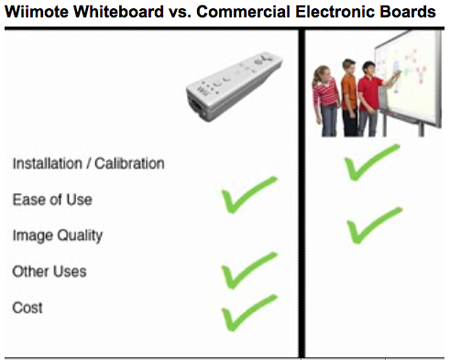Drew McKinney—who I hope winds up in Bloomington next year in the HCI/d program at Indiana University—just released his video comparing Johnny Lee’s Wiimote Whiteboard hack with commercial smart boards, like the one used in his mom’s middle school classroom.
Drew McKinney compares a Wiimote Whiteboard with a commercial option
Drew noted that there are two main weaknesses with commercial options: reliance on dedicated hardware, and the poor quality of their touch sensitivity. The markers have identity embedded in them, which means selection of colors requires the system knowing that the blue marker, for example, is back in its cradle. It is also common to have hand movements misinterpreted as marks, which can lead to a frustrating experience for users.
The wiimote whiteboard isn’t a perfect option, either. The quality of the lines are jagged, although Lee attributes that primarily to placement of the wiimote. McKinney suggests using a microphone stand instead of a table mount to help facilitate fine-tuned placement and lessen the chance of disturbances, like jostling the device when accidentally kicking the table. However, the versatility it provides by allowing the interaction to occur on any surface, like walls and tables, and scale to practically any size makes it significantly more adaptable to individual needs. Since the pen serves as a mouse, the functionality can be more than just marking a wall. It may be a nice way to demonstrate applications and play games in front of a group.
The biggest difference, of course, is the cost. It cost about $50 to create Lee’s wiimote version, whereas vendors charge upwards of $3000 for smart boards.
